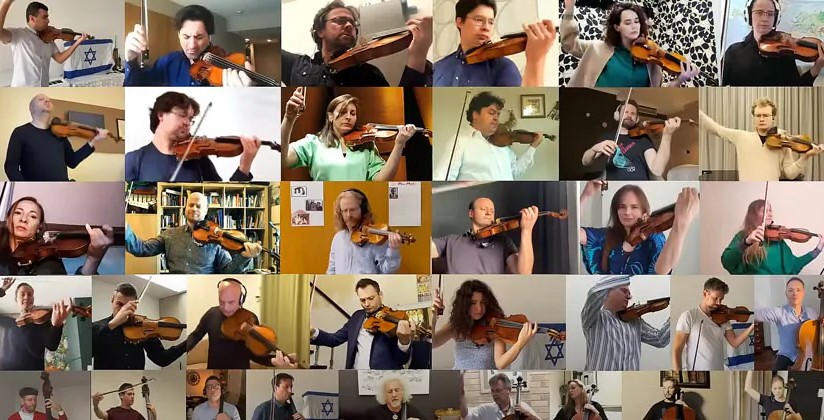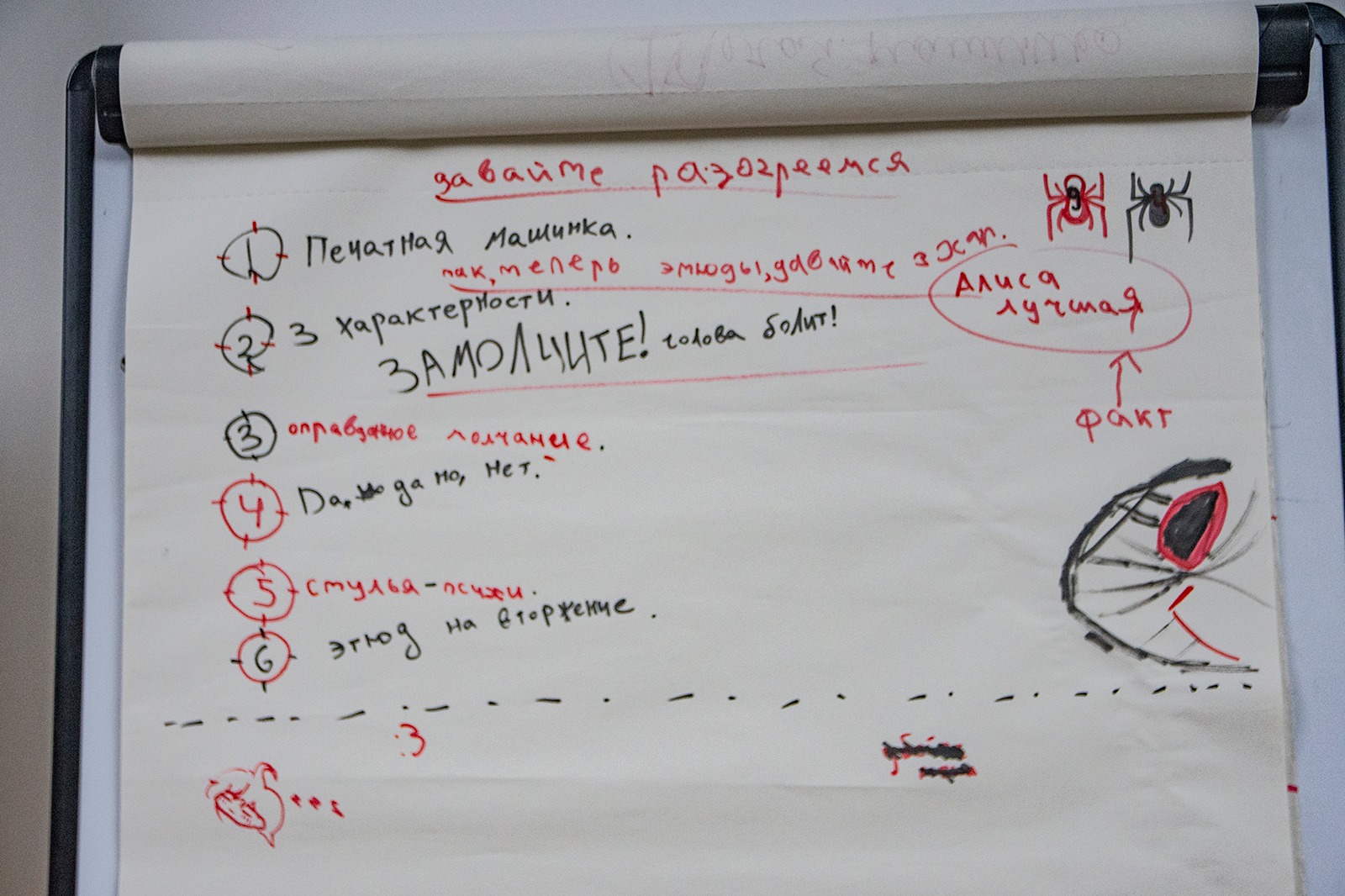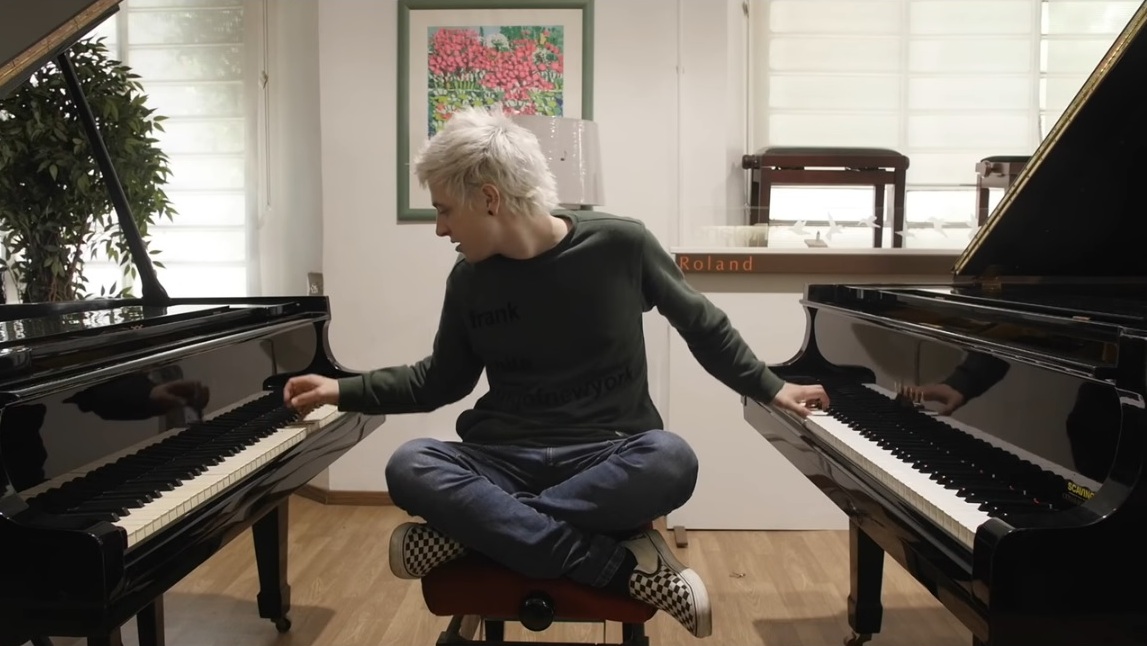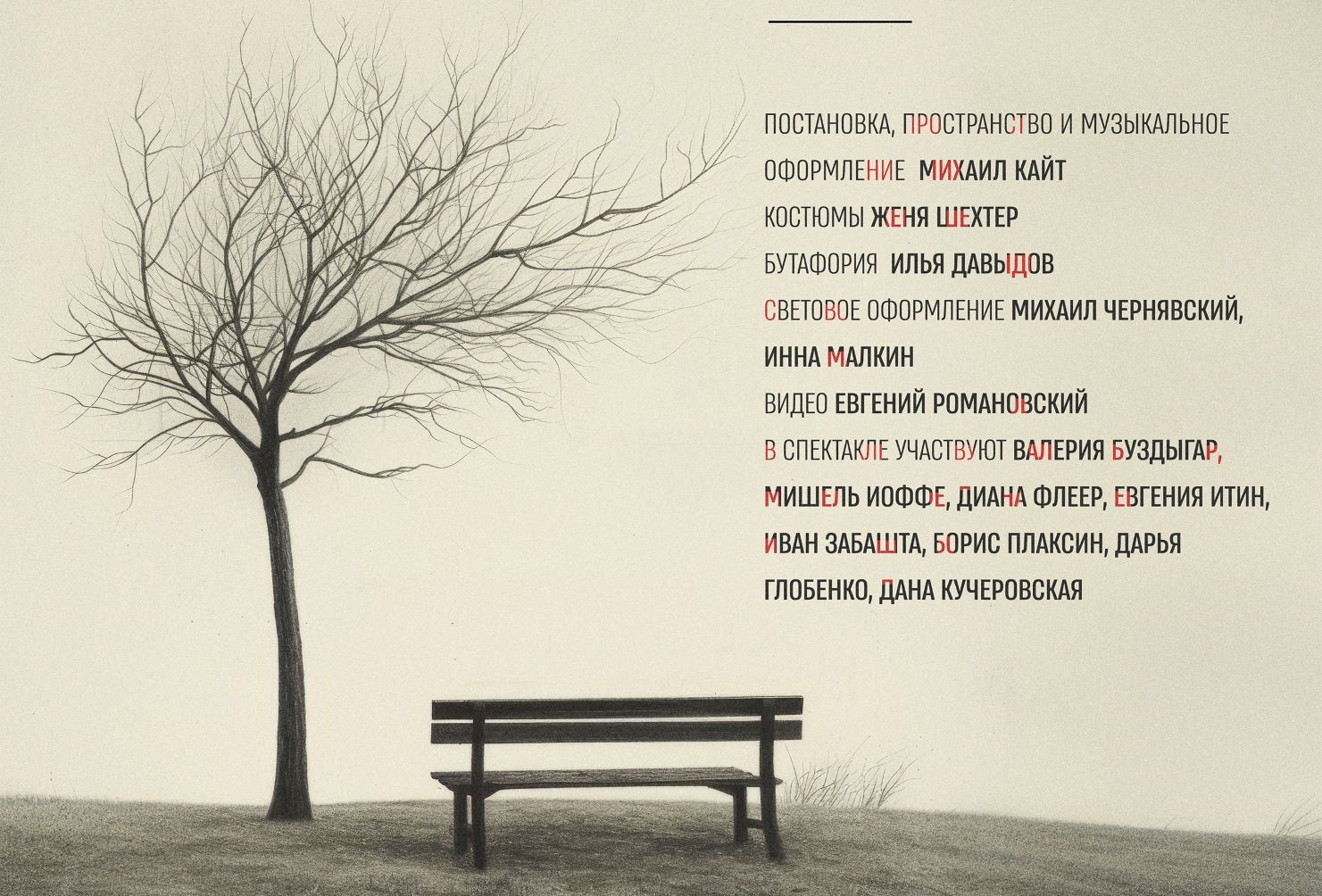«Паразиты» Пон Чжун Хо
Нечто столь же прекрасное, что и «Магазинные воришки», только с бо́льшим драйвом. Начинаешь совершенно иначе воспринимать философию бытия (не азиаты мы...) и улавливать запах бедности.
«Паразиты» – первый южнокорейский фильм, удостоенный «Золотой пальмовой ветви» Каннского фестиваля. Снял шедевр Пон Чжун Хо, в привычном для себя мультижанре, а именно в жанре «пончжунхо». Как всегда, цепляет.
«Синонимы» Надава Лапида
По словам режиссера, почти всё, что происходит в фильме с Йоавом, в том или ином виде случилось с ним самим, когда он после армии приехал в Париж. У Йоава (чей тезка, библейский Йоав был главнокомандующим царя Давида, взявшим Иерусалим) – посттравма и иллюзии, замешанные на мифе о герое Гекторе, защитнике Трои. Видно, таковым он себя и воображает, когда устраивается работать охранником в израильское посольство и когда учит французский в OFII. Но ведь научиться говорить на языке великих философов еще не значит расстаться с собственной идентичностью и стать французом. Сначала надо взять другую крепость – самого себя.
«Frantz» Франсуа Озона
В этой картине сходятся черное и белое (хотя невзначай, того и гляди, вдруг проглянет цветное исподнее), витальное и мортальное, французское и немецкое. Персонажи переходят с одного языка на другой и обратно, зрят природу в цвете от избытка чувств, мерещат невесть откуда воскресших юношей, играющих на скрипке, и вообще чувствуют себя неуютно на этом черно-белом свете. Французы ненавидят немцев, а немцы французов, ибо действие происходит аккурат после Первой мировой. Разрушенный войной комфортный мир сместил систему тоник и доминант, и Франсуа Озон поочередно запускает в наши (д)уши распеваемую народным хором «Марсельезу» и исполняемую оркестром Парижской оперы «Шехерезаду» Римского-Корсакова. На территории мучительного диссонанса, сдобренного не находящим разрешения тристан-аккордом, и обретаются герои фильма. Оттого распутать немецко-французскую головоломку зрителю удается далеко не сразу.
«Патерсон» Джима Джармуша
В этом фильме всё двоится: стихотворец Патерсон и городишко Патерсон, bus driver и Адам Драйвер, волоокая иранка Лаура и одноименная муза Петрарки, японец Ясудзиро Одзу и японец Масатоси Нагасэ, черно-белые интерьеры и черно-белые капкейки, близнецы и поэты. Да, здесь все немножко поэты, и в этом как раз нет ничего странного. Потому что Джармуш и сам поэт, и фильмы свои он складывает как стихи. Звуковые картины, настоянные на медитации, на многочисленных повторах, на вроде бы рутине, а в действительности – на нарочитой простоте мироздания. Ибо любой поэт, даже если он не поэт, может начать всё с чистого листа.
«Ужасных родителей» Жана Кокто
Необычный для нашего пейзажа режиссер Гади Ролл поставил в Беэр-Шевском театре спектакль о французах, которые говорят быстро, а живут смутно. Проблемы – вечные, старые, как мир: муж охладел к жене, давно и безвозвратно, а она не намерена делить сына с какой-то женщиной, и оттого кончает с собой. Жан Кокто, драматург, поэт, эстет, экспериментатор, был знаком с похожей ситуацией: мать его возлюбленного Жана Маре была столь же эгоистичной.
Сценограф Кинерет Киш нашла правильный и стильный образ спектакля – что-то среднее между офисом, складом, гостиницей, вокзалом; место нигде. Амир Криеф и Шири Голан, уникальный актерский дуэт, уже много раз создававший настроение причастности и глубины в разном материале, достойно отыгрывает смятенный трагифарс. Жан Кокто – в Беэр-Шеве. Новые сказки для взрослых
Хоть и пичкали нас в детстве недетскими и отнюдь не невинными сказками Шарля Перро и братьев Гримм, знать не знали и ведать не ведали мы, кто все это сотворил. А началось все со «Сказки сказок» - пентамерона неаполитанского поэта, писателя, солдата и госчиновника Джамбаттисты Базиле. Именно в этом сборнике впервые появились прототипы будущих хрестоматийных сказочных героев, и именно по этим сюжетам-самородкам снял свои «Страшные сказки» итальянский режиссер Маттео Гарроне. Правда, под сюжетной подкладкой ощутимо просматриваются Юнг с Грофом и Фрезером, зато цепляет. Из актеров, коих Гарроне удалось подбить на эту авантюру, отметим Сальму Хайек в роли бездетной королевы и Венсана Касселя в роли короля, влюбившегося в голос старушки-затворницы. Из страннейших типов, чьи портреты украсили бы любую галерею гротеска, - короля-самодура (Тоби Джонс), который вырастил блоху до размеров кабана под кроватью в собственной спальне. Отметим также невероятно красивые с пластической точки зрения кадры: оператором выступил поляк Питер Сушицки, явно черпавший вдохновение в иллюстрациях старинных сказок Эдмунда Дюлака и Гюстава Доре.
Kutiman Mix the City
Kutiman Mix the City – обалденный интерактивный проект, выросший из звуков города-без-перерыва. Основан он на понимании того, что у каждого города есть свой собственный звук. Израильский музыкант планетарного масштаба Офир Кутель, выступающий под псевдонимом Kutiman, король ютьюбовой толпы, предоставляет всем шанс создать собственный ремикс из звуков Тель-Авива – на вашей собственной клавиатуре. Смикшировать вибрации города-без-перерыва на интерактивной видеоплатформе можно простым нажатием пальца (главное, конечно, попасть в такт). Приступайте.
Видеоархив событий конкурса Рубинштейна
Все события XIV Международного конкурса пианистов имени Артура Рубинштейна - в нашем видеоархиве! Запись выступлений участников в реситалях, запись выступлений финалистов с камерными составами и с двумя оркестрами - здесь. Альбом песен Ханоха Левина
Люди на редкость талантливые и среди коллег по шоу-бизнесу явно выделяющиеся - Шломи Шабан и Каролина - объединились в тандем. И записали альбом песен на стихи Ханоха Левина « На побегушках у жизни». Любопытно, что язвительные левиновские тексты вдруг зазвучали нежно и трогательно. Грустинка с прищуром, впрочем, сохранилась.
«Год, прожитый по‑библейски» Эя Джея Джейкобса
...где автор на один год изменил свою жизнь: прожил его согласно всем законам Книги книг.
«Подозрительные пассажиры твоих ночных поездов» Ёко Тавада
Жизнь – это долгое путешествие в вагоне на нижней полке.
Скрюченному человеку трудно держать равновесие. Но это тебя уже не беспокоит. Нельзя сказать, что тебе не нравится застывать в какой-нибудь позе. Но то, что происходит потом… Вот Кузнец выковал твою позу. Теперь ты должна сохранять равновесие в этом неустойчивом положении, а он всматривается в тебя, словно посетитель музея в греческую скульптуру. Потом он начинает исправлять положение твоих ног. Это похоже на внезапный пинок. Он пристает со своими замечаниями, а твое тело уже привыкло к своему прежнему положению. Есть такие части тела, которые вскипают от возмущения, если к ним грубо прикоснуться. «Комедию д'искусства» Кристофера Мура
На сей раз муза-матерщинница Кристофера Мура подсела на импрессионистскую тему. В июле 1890 года Винсент Ван Гог отправился в кукурузное поле и выстрелил себе в сердце. Вот тебе и joie de vivre. А все потому, что незадолго до этого стал до жути бояться одного из оттенков синего. Дабы установить причины сказанного, пекарь-художник Люсьен Леззард и бонвиван Тулуз-Лотрек совершают одиссею по богемному миру Парижа на излете XIX столетия.
В романе «Sacré Bleu. Комедия д'искусства» привычное шутовство автора вкупе с псевдодокументальностью изящно растворяется в Священной Сини, подгоняемое собственным муровским напутствием: «Я знаю, что вы сейчас думаете: «Ну, спасибо тебе огромное, Крис, теперь ты всем испортил еще и живопись». «Пфитц» Эндрю Крами
Шотландец Эндрю Крами начертал на бумаге план столицы воображариума, величайшего града просвещения, лихо доказав, что написанное существует даже при отсутствии реального автора. Ибо «язык есть изощреннейшая из иллюзий, разговор - самая обманчивая форма поведения… а сами мы - измышления, мимолетная мысль в некоем мозгу, жест, вряд ли достойный толкования». Получилась сюрреалистическая притча-лабиринт о несуществующих городах - точнее, существующих лишь на бумаге; об их несуществующих жителях с несуществующими мыслями; о несуществующем безумном писателе с псевдобиографией и его существующих романах; о несуществующих графах, слугах и видимости общения; о великом князе, всё это придумавшем (его, естественно, тоже не существует). Рекомендуется любителям медитативного погружения в небыть.
«Тинтина и тайну литературы» Тома Маккарти
Что такое литературный вымысел и как функционирует сегодня искусство, окруженное прочной медийной сетью? Сей непростой предмет исследует эссе британского писателя-интеллектуала о неунывающем репортере с хохолком. Появился он, если помните, аж в 1929-м - стараниями бельгийского художника Эрже. Неповторимый флёр достоверности вокруг вымысла сделал цикл комиксов «Приключения Тинтина» культовым, а его герой получил прописку в новейшей истории. Так, значит, это литература? Вроде бы да, но ничего нельзя знать доподлинно.
«Неполную, но окончательную историю...» Стивена Фрая
«Неполная, но окончательная история классической музыки» записного британского комика - чтиво, побуждающее мгновенно испустить ноту: совершенную или несовершенную, голосом или на клавишах/струнах - не суть. А затем удариться в запой - книжный запой, вестимо, и испить эту чашу до дна. Перейти вместе с автором от нотного стана к женскому, познать, отчего «Мрачный Соломон сиротливо растит флоксы», а правая рука Рахманинова напоминает динозавра, и прочая. Всё это крайне занятно, так что... почему бы и нет?
Тайские роти
Истинно райское лакомство - тайские блинчики из слоеного теста с начинкой из банана. Обжаривается блинчик с обеих сторон до золотистости и помещается в теплые кокосовые сливки или в заварной крем (можно использовать крем из сгущенного молока). Подается с пылу, с жару, украшенный сверху ледяным кокосовым сорбе - да подается не абы где, а в сиамском ресторане «Тигровая лилия» (Tiger Lilly) в тель-авивской Сароне. Шомлойскую галушку
Легендарная шомлойская галушка (somlói galuska) - винтажный ромовый десерт, придуманный, по легенде, простым официантом. Отведать ее можно практически в любом ресторане Будапешта - если повезет. Вопреки обманчиво простому названию, сей кондитерский изыск являет собой нечто крайне сложносочиненное: бисквит темный, бисквит светлый, сливки взбитые, цедра лимонная, цедра апельсиновая, крем заварной (патисьер с ванилью, ммм), шоколад, ягоды, орехи, ром... Что ни слой - то скрытый смысл. Прощай, талия.
Бисквитную пасту Lotus с карамелью
Классическое бельгийское лакомство из невероятного печенья - эталона всех печений в мире. Деликатес со вкусом карамели нужно есть медленно, миниатюрной ложечкой - ибо паста так и тает во рту. Остановиться попросту невозможно. Невзирая на калории.
Шоколад с васаби
Изысканный тандем - горький шоколад и зеленая японская приправа - кому-то может показаться сочетанием несочетаемого. Однако распробовавшие это лакомство считают иначе. Вердикт: правильный десерт для тех, кто любит погорячее. А также для тех, кто недавно перечитывал книгу Джоанн Харрис и пересматривал фильм Жерара Кравчика.
Торт «Саркози»
Как и Париж, десерт имени французского экс-президента явно стоит мессы. Оттого и подают его в ресторане Messa на богемной тель-авивской улице ха-Арбаа. Горько-шоколадное безумие (шоколад, заметим, нескольких сортов - и все отменные) заставляет поверить в то, что Саркози вернется. Не иначе.
|
 |
The Queen of Sheba arrives in Tel Aviv
| 25.07.2019 |
The State Opera House of Hungary will arrive in Israel for the first time with Queen of Sheba, the immortal opera of the Hungarian Jewish composer Karl Goldmark, to the libretto of Salomon Hermann Mosenthal. A story about love and disappointment, desire and death in the court of King Solomon in Jerusalem and at the Judean Desert. A Late 19th century opera presents impressive romantic and dramatic music
TICKETS
“Die Königin von Saba is a kind of mixture of French grand opéra and early Romantic German opera, spiced with the ingenuity of composer Karl Goldmark and a strong oriental streak. I find this musical composition to be built upon a very interesting structure. All of the characters are given individual personalities, and a great deal of their emotions and actions are characteristic of the 19th century. However, what is perhaps the most important message to our own age is the possibility that anyone can lose themselves. And how difficult it may be to find ourselves again! Especially in our era, when things that earlier gave us support have become unstable. When ideas, including the religion that we previously relied on, are exchanged for the goods of a consumer society that tempt us like “false idols” – to use a Biblical expression. We tend to yield easily, which affects our personalities and even our relationships with ourselves.
In Die Königin von Saba, it is of course Assad who loses himself by falling in love with the queen the day before his wedding. The figure of Assad is in a way a dual role: on the one hand, it requires a heroic presence, and on the other hand, his uncertainty at times betrays a somewhat childlike character. He is a complicated person, struggling with questions of desire, faith, honor, and redemption. Technically, his part is a terribly difficult one to sing – not many singers are able to do it. A large spectrum of vocal colors is needed to subtly express Assad’s different psychological states.
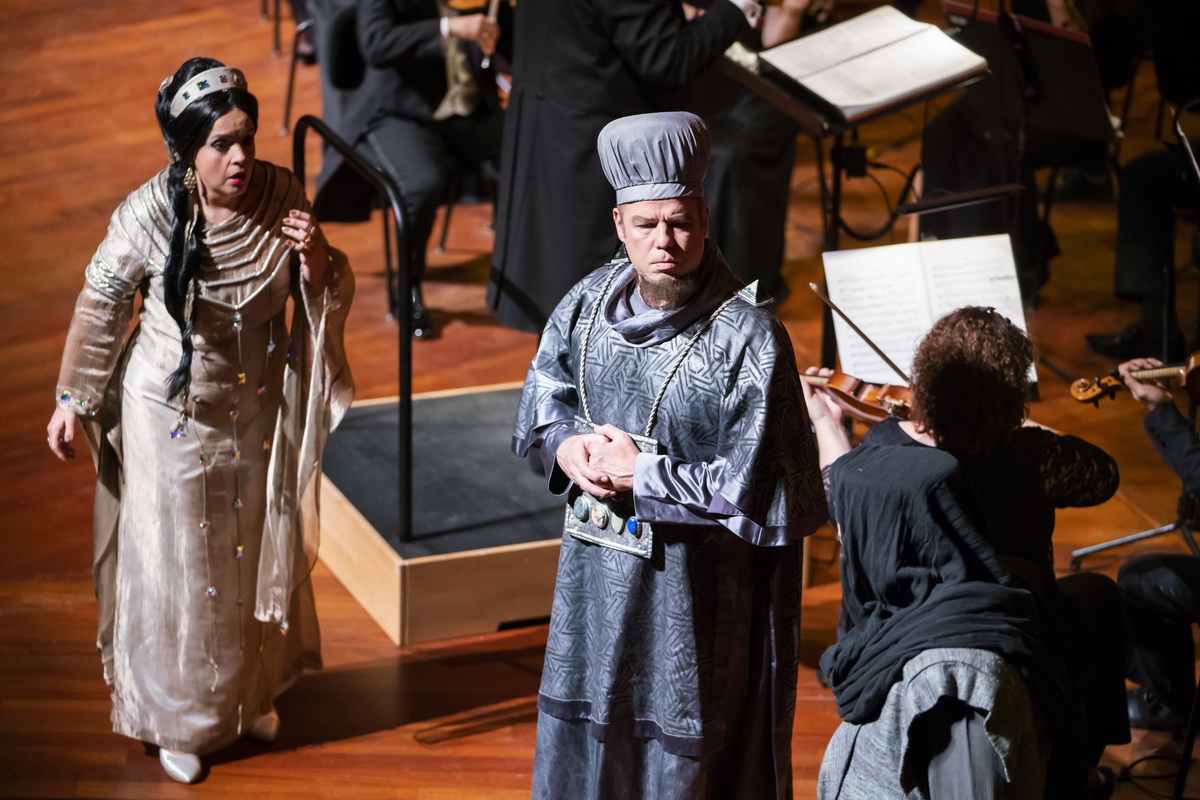
Similarly, the Queen of Sheba is also a complex figure. She is a femme fatale, a queen and ruler who manipulates others with both her beauty and her rank. Nevertheless, she is the one who suffers the greatest loss in the opera. When she finally realizes that she has really fallen in love with Assad and is ready to sacrifice everything for him, she is rejected by him. This means that all of her intrigues and tricks have been in vain, making her the one who suffers the most.
The Queen of Sheba is the personification of beauty and, most importantly, the world’s treasure. She embodies the luxury and consumerism of that era. She only goes to Jerusalem because she wants to meet King Solomon, as she has been curious about his wisdom. But Solomon is not fooled by the queen’s intrigues, and his advice to Assad is indeed wise and useful even to us today: ‘It is within yourself where you should find what you have lost.’” (Written by stage director Csaba Káel)

“Knowing about Goldmark's career and how the opera was received, the question inevitably arises: why did his music, including Die Königin von Saba, disappear from public consciousness? And what, even so, is unique about this work? Why is this an important moment for it to be staged?
Goldmark is a composer yet to be discovered, but he is not the only one from his era who is neglected. Of course, he could not count on too much support in his lifetime if the Wagnerian Hanslick had the power to decide his fate. It is easy to make a summary judgment. With regard to the compositional arsenal he deploys in Die Königin von Saba, those who do not listen carefully enough might say that he uses too many diminished seventh chords... Although the fact is simply that it has a very diverse and bold harmonic world. He occasionally uses “forbidden” harmonic progressions for the sake of dramatic effect; a well-bred conservatory student would never write such things. But these are actually fantastic. What makes me like this opera is its emotional layer, for which the composer finds the appropriate notes as well.
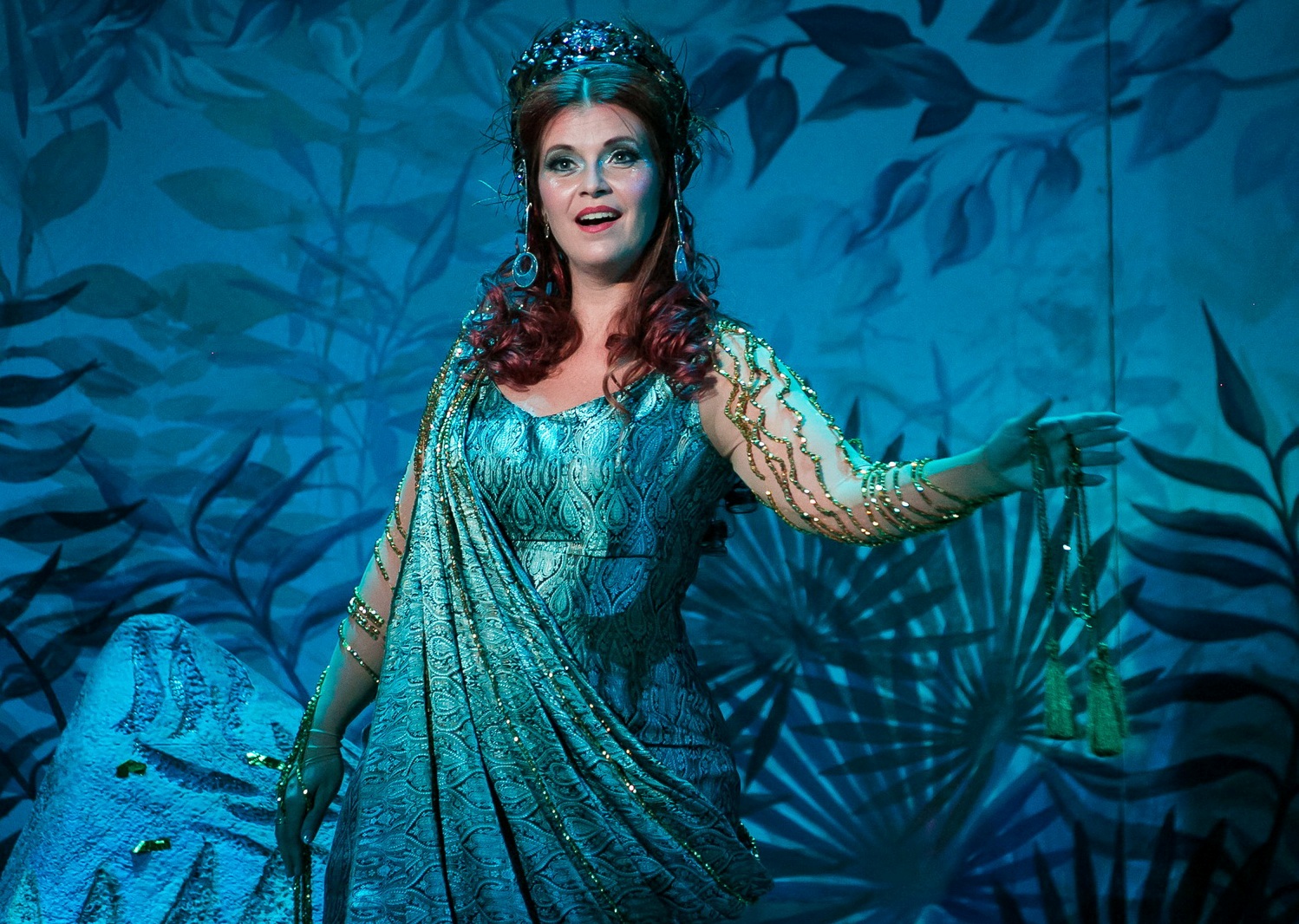
The inclination to present it might also be influenced by the fact that the three principal roles are very difficult. They require singers with exceptional abilities, who at given moments have to reach the limits of their capabilities. There are some pieces that can create an illusion even with a mediocre performance, and there are others that cannot tolerate this. Die Königin von Saba belongs to the latter category. The unbridled fantasy keeps it within such loose limits that it provides critics with a point of vulnerability – and if the very sensitive orchestral material isn’t played with the appropriate meaning and fullness, then the musical and mental transformations that cause the same kind of changes in the character as a superbly conceived change of scene on the stage does will not occur. Goldmark, as he himself wrote, composed a train of thought, following the inspiration of the libretto. This is what we have to follow too, with intensity and richness.
Nowadays, we are usually ashamed of these emotions; let's just say that they are not modern. But this is exactly what people need today: finding moments in this very modern world when they can float half a meter above the ground.” (Written by conductor János Kovács)
Background and history
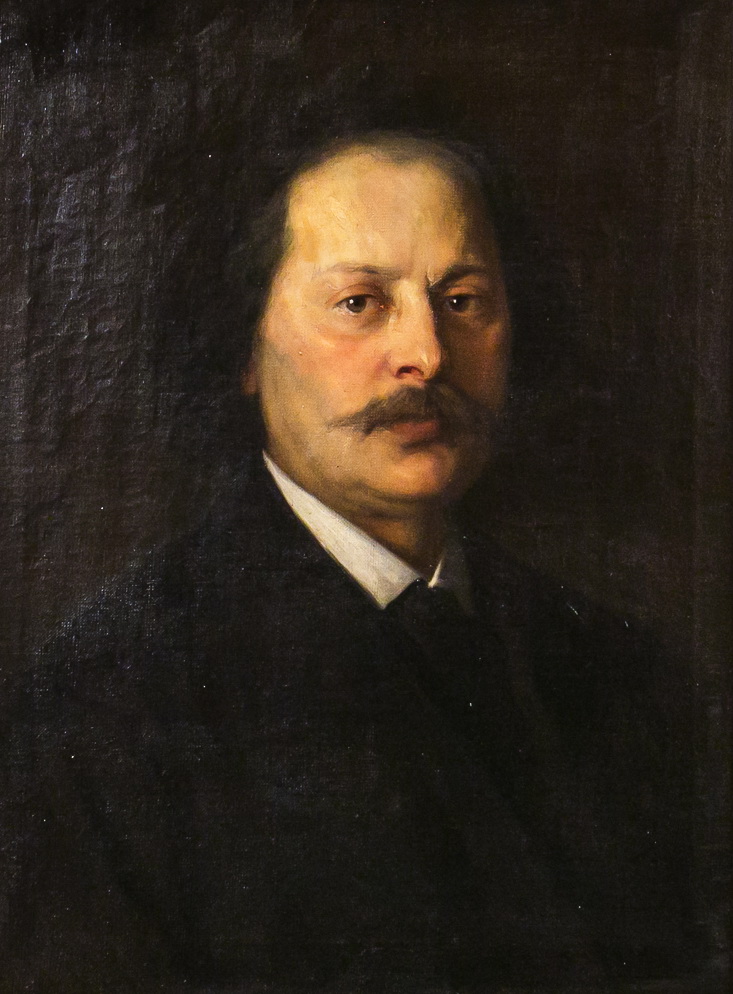 Karl (Károly) Goldmark was born in Keszthely in 1830 and died in 1915. During his 85 years, the world – including in terms of musical history – went through astounding changes. At his birth, the dual Austro-Hungarian Empire was still a unified political entity ruled by Austria. Culture moved completely freely both within the Empire and throughout Europe. At the time when Goldmark was born, the greatest and most important composers of Romanticism – Beethoven, Schubert, Berlioz, Rossini, Mendelssohn, Chopin, Schumann, Liszt, Verdi, and Wagner – were either recently dead or busy at work. And Goldmark was still alive and working when the outlines of the new music were beginning to appear. At the moment of his death in 1915, the world was in flames, the First World War was entering its second year, and the face of Europe was changing forever. Bartók was working on The Wooden Prince, with Bluebeard's Castle and the first two string quartets already behind him. Kodály was just eight years away from composing Psalmus Hungaricus. Stravinsky had already composed his three great ballets (The Rite of Spring, The Firebird, and Petrushka). Karl (Károly) Goldmark was born in Keszthely in 1830 and died in 1915. During his 85 years, the world – including in terms of musical history – went through astounding changes. At his birth, the dual Austro-Hungarian Empire was still a unified political entity ruled by Austria. Culture moved completely freely both within the Empire and throughout Europe. At the time when Goldmark was born, the greatest and most important composers of Romanticism – Beethoven, Schubert, Berlioz, Rossini, Mendelssohn, Chopin, Schumann, Liszt, Verdi, and Wagner – were either recently dead or busy at work. And Goldmark was still alive and working when the outlines of the new music were beginning to appear. At the moment of his death in 1915, the world was in flames, the First World War was entering its second year, and the face of Europe was changing forever. Bartók was working on The Wooden Prince, with Bluebeard's Castle and the first two string quartets already behind him. Kodály was just eight years away from composing Psalmus Hungaricus. Stravinsky had already composed his three great ballets (The Rite of Spring, The Firebird, and Petrushka).
From his unschooled provincial childhood to receiving an honorary doctorate in Budapest, composer Karl Goldmark’s life passed many interesting milestones, and a few exciting ones. The poverty-stricken violinist and composer who played in theater orchestras and gave piano lessons to make ends meet was already 45 when the stage finally opened up for him, which was followed by international recognition.
During his lifetime, Die Königin von Saba was performed in 30 opera houses around the world in nine languages, with the composer himself directing most of the productions. One might ask what happened to all this popularity. Regarded today as the output of a minor composer, his works are rarely played at opera houses or on concert stages. This makes opportunities to encounter his remarkable music all the more pleasurable and exciting.
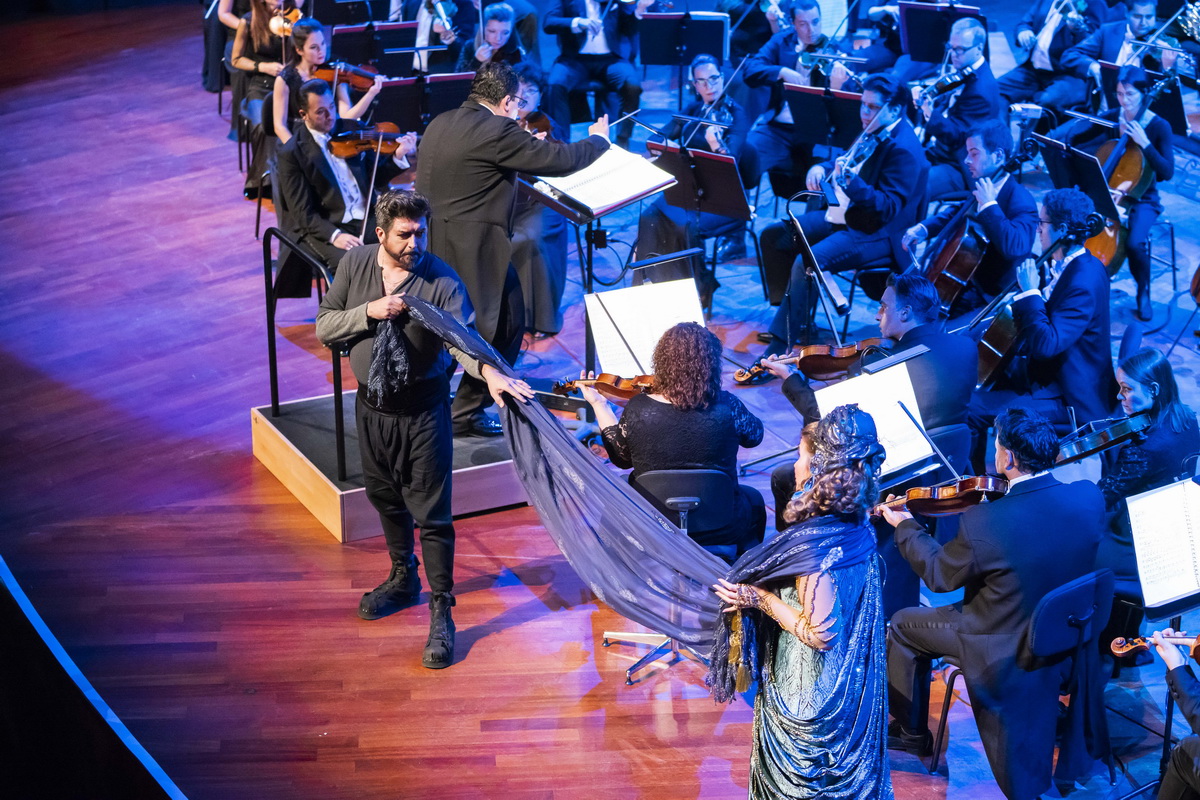
“Die Königin von Saba” was the work that put its Hungarian-Jewish composer on the operatic map at its first performance in Vienna in 1875. It was hugely popular on both sides of the Atlantic in its day, though in Britain, the Lord Chamberlain’s prohibition against the theatrical representation of Biblical subjects prevented its being heard in London until 1910. Strauss and Mahler were among its many conductors. Caruso was one of several star tenors to play Assad, whose uncontrollable desire for the Queen of Sheba destroys his relationship with his intended bride Sulamith. Lilli Lehmann included both principal female roles in her considerable repertory. Its popularity waned after the First World War, though it was revived annually in Vienna until 1938, when the Nazis banned it.
Goldmark is usually dismissed as eclectic, though his work can also be viewed as adopting a cosmopolitan stance at a time of growing nationalism. Just as he saw no inherent dichotomy between Brahms (a friend) and Wagner (he liked the music but not the man or his opinions), so he perceived no disjunction between elements of Wagnerian methodology and post-Meyerbeerian grand opera. With its four-act/five-scene structure, ballets, grand ceremonials and complex theatrical demands (Assad dies in a sandstorm), Die Königin von Saba is in many ways a fine example of the latter. Goldmark deploys closed forms – the set-piece arias can be analysed in terms of recitative, cavatina and cabaletta – and avoids anything approximating the symphonic development of thematic material. The Wagnerisms lie elsewhere.
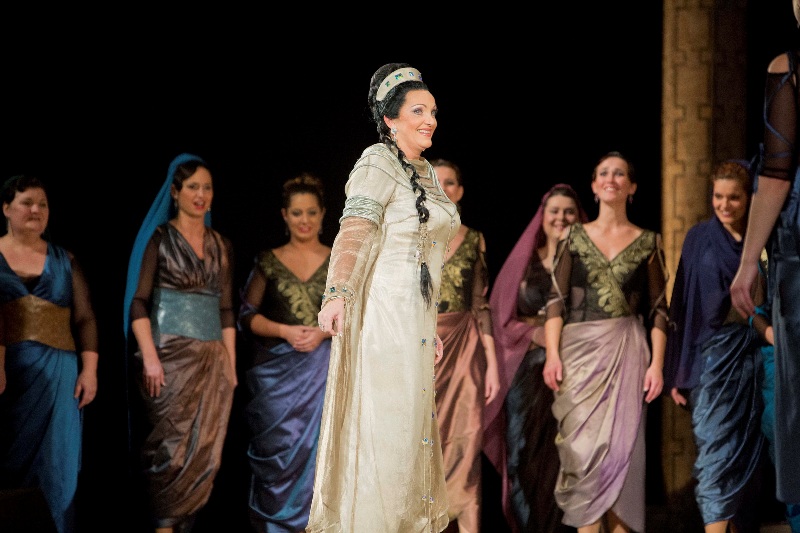
Although these are obvious influences in the work, Goldmark's individuality is apparent. The music for the Queen of Sheba displays a sultry eroticism with oriental flair. The music for the High Priest and other religious characters recalls Jewish religious music and at times the music of Sarastro in The Magic Flute. The religious character of these parts of the opera may well have been influenced by the ideas of the great Viennese cantor Salomon Sulzer, who was concerned with restoring Jewish music to its oriental origins.
Synopsis
Place and Time: Jerusalem and the surrounding desert, 10th Century BC.
Act 1: A hall in Solomon’s palace
Sulamith, the daughter of the High Priest, is anxiously waiting for her fiancé, Assad, to return to court from his diplomatic assignment to plan for the arrival of the Queen of Sheba to the court of King Solomon. The couple are scheduled to marry the following day. Upon his return to the palace, Assad meets with Solomon and reveals to him that he has fallen in love with a mysterious woman among the cedar forests of Lebanon and does not love Sulamith. Before Solomon can reply, the Queen of Sheba arrives with her entourage. As she greets the king, she pulls back her veil, revealing to Assad that she is in fact the mysterious woman he had met on his journey. The queen, however, pretends not to know Assad to his confusion. After the queen leaves, Solomon counsels Assad to not pursue his infatuation but to continue with his marriage to Sulamith.
Act 2: The garden of the palace at night
The Queen of Sheba has slipped away from the social gathering being held in her honor inside the palace. As she reflects on Assad's impending marriage, Astaroth, her slave, informs her that Assad is nearby and then proceeds to lure Assad to her mistress with a seductive oriental vocalise ("Magische Töne"). Assad and the Queen engage in a fervent conversation that climaxes in a passionate duet and embrace. The Guardian of the Temple arrives at daybreak and disrupts their tryst with a call for the Sons of Israel to pray.
The wedding party arrives and Assad and Sulamith are about to be married in front of the Ark of the Covenant when the Queen appears to give a wedding present. The Queen continues to treat Assad like a stranger which throws him into distress. He commits blasphemy by referring to the Queen as his god, causing an uproar which ends the wedding ceremony. Assad is led off to await punishment, most likely his execution.
Act 3: The court of King Solomon
Celebrations in honour of the Queen of Sheba continue with a performance of Bienentanz der Almeen, a ballet, and a bacchanal. Worried for Assad's fate, the Queen pleads for Solomon to give Assad mercy. He refuses and the Queen leaves plotting revenge. Sulamith, along with her companions, enter the court singing a mournful song. She too pleads for Assad's life to be spared in an aria that eventually culminates into a large ensemble. Still unmoved, Solomon replies with an ominous prophecy about Sulamith's fate. Distraught, she leaves the palace for the desert to bewail her impending future.
Act 4: The vicinity of Sulamith's desert retreat
Assad has been banished by Solomon to the desert. The Queen of Sheba seeks him out to attempt to convince him to come back with her to her kingdom. She finds him alone, not too far from Sulamith's retreat, and tries to seduce him. He rejects her advances and in a bitter soliloquy reveals his regret and desire for a death that might redeem his offense against God. Assad then prays for Sulamith, during which time he is engulfed in a violent sandstorm. He is later found barely alive by Sulamith and her companions. He begs for her forgiveness, which she bestows just before he dies in her arms.
Musical analysis Die Königin von Saba is written in the style of grand opera; with the usual large-scale cast and orchestra, the use of local color, and a plot set in history all typical of that genre. The vocal writing includes solo recitative and aria passages, duets, and large-scale choruses. Notable moments of the opera include Assad’s short arietta "Magische Töne" in Act 2 and the final duet in Act 4, both of which display Goldmark's lyricism at its best.
Following the world premiere in 1875, The Queen of Sheba enjoyed success all over the world, even at the Metropolitan Opera. Then, at the beginning of the 20th century, like the French grand operas by Meyerbeer and his contemporaries slowly disappeared from the repertoires of the theaters. Only the famous tenor aria Magische töne survived into the concert repertoire of such legends as Caruso, Leo Slezak, Nicolai Gedda, Roberto Alagna.
The work had its Hungarian premiere in Budapest at the National Theatre in 1876. The Royal Hungarian Opera (opened in 1884, today: Hungarian State Opera) put it on stage in its first season, in 1885. It was kept on repertoire until 1838. Afterwards, the works of Goldmark – similarly to those of Mendelssohn-Bartholdy or Offenbach), disappeared from the Hungarian operatic and concert stage. The Queen of Sheba had a revival in 1945, and remained on repertoire until 1972. Following a longer hiatus, it returned to the programme in the production by Csaba Káel in 2015.
The current production of the Hungarian State Opera was shown at the David H. Koch Theater in New York in November 2018 to great critical acclaim.
Hungarian State Opera
Karl Goldmark: The Queen of Sheba
Conductor: Balázs Kocsár
Chorus director: Gábor Csiki
Over 170 participants are in this concert performance
Cast
Queen of Sheba: Erika Gál
Assad: Boldizsár László
Sulamith: Eszter Sümegi
King Solomon: Zoltán Kelemen
High priest: András Palerdi
Astaroth: Katalin Töreky
Baal-Hanan: Róbert Rezsnyák
Temple Watchman: Ferenc Cserhalmi
The Israeli Opera, September 10, 20:00.
Photos by Nagy Attila, Berecz Valter, Rakossy Peter
To purchase tickets |





Field 'text' doesn't have a default value Read more:
|
 |
Элишева Несис.
«Стервозное танго»

|





 Karl (Károly) Goldmark was born in Keszthely in 1830 and died in 1915. During his 85 years, the world – including in terms of musical history – went through astounding changes. At his birth, the dual Austro-Hungarian Empire was still a unified political entity ruled by Austria. Culture moved completely freely both within the Empire and throughout Europe. At the time when Goldmark was born, the greatest and most important composers of Romanticism – Beethoven, Schubert, Berlioz, Rossini, Mendelssohn, Chopin, Schumann, Liszt, Verdi, and Wagner – were either recently dead or busy at work. And Goldmark was still alive and working when the outlines of the new music were beginning to appear. At the moment of his death in 1915, the world was in flames, the First World War was entering its second year, and the face of Europe was changing forever. Bartók was working on The Wooden Prince, with Bluebeard's Castle and the first two string quartets already behind him. Kodály was just eight years away from composing Psalmus Hungaricus. Stravinsky had already composed his three great ballets (The Rite of Spring, The Firebird, and Petrushka).
Karl (Károly) Goldmark was born in Keszthely in 1830 and died in 1915. During his 85 years, the world – including in terms of musical history – went through astounding changes. At his birth, the dual Austro-Hungarian Empire was still a unified political entity ruled by Austria. Culture moved completely freely both within the Empire and throughout Europe. At the time when Goldmark was born, the greatest and most important composers of Romanticism – Beethoven, Schubert, Berlioz, Rossini, Mendelssohn, Chopin, Schumann, Liszt, Verdi, and Wagner – were either recently dead or busy at work. And Goldmark was still alive and working when the outlines of the new music were beginning to appear. At the moment of his death in 1915, the world was in flames, the First World War was entering its second year, and the face of Europe was changing forever. Bartók was working on The Wooden Prince, with Bluebeard's Castle and the first two string quartets already behind him. Kodály was just eight years away from composing Psalmus Hungaricus. Stravinsky had already composed his three great ballets (The Rite of Spring, The Firebird, and Petrushka).



